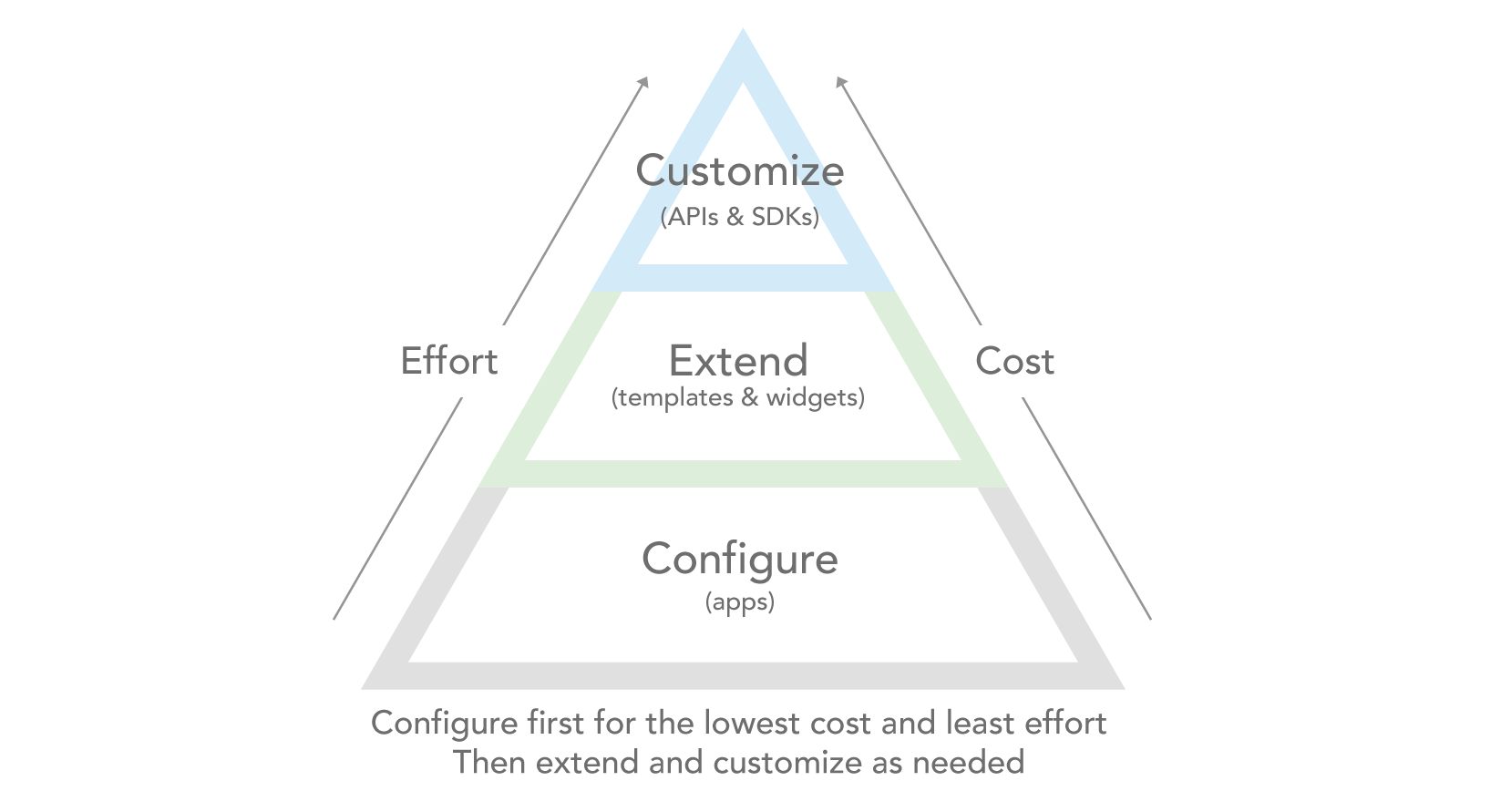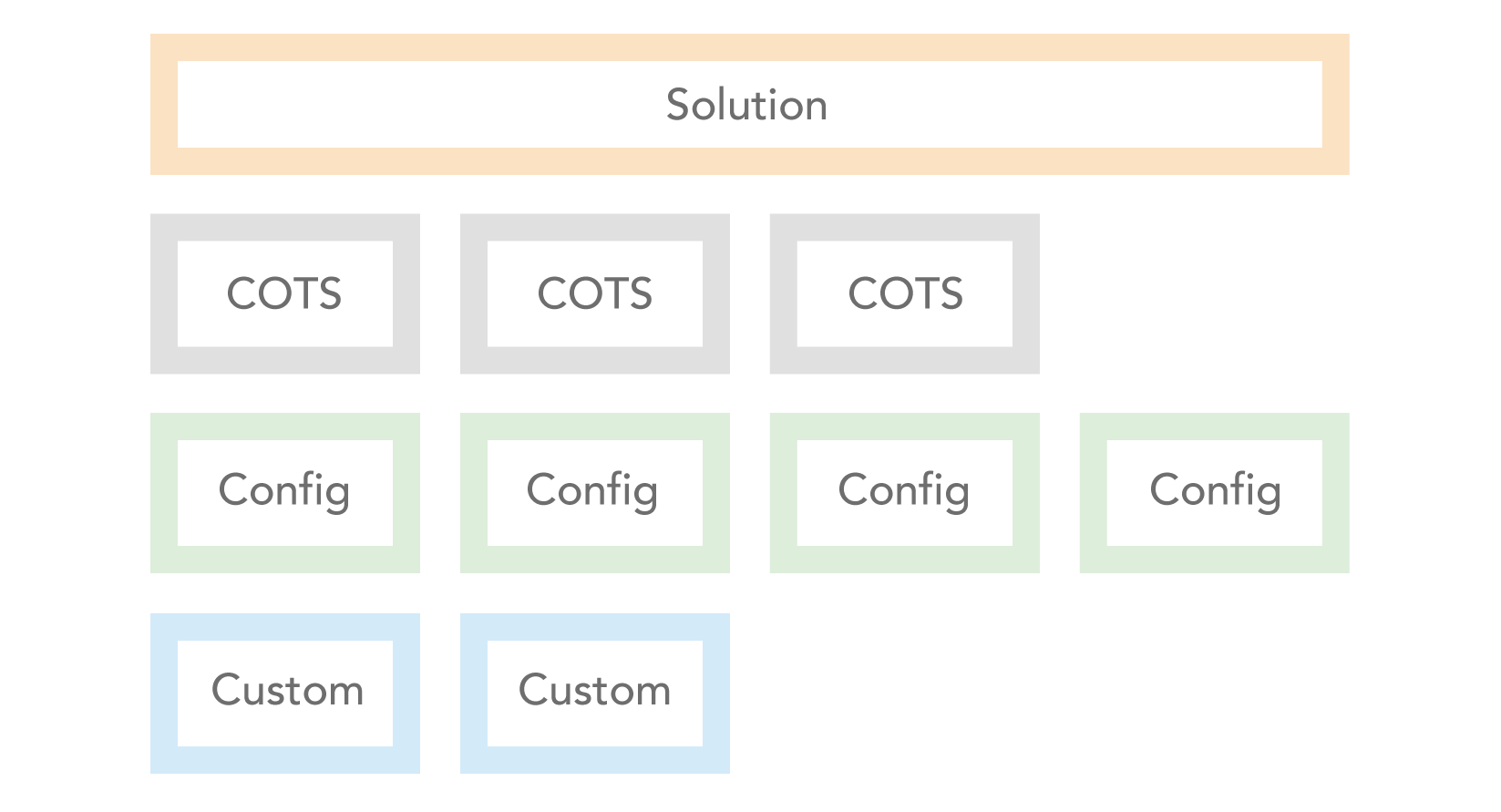Application implementation strategy
As organizations embrace the power of geospatial technology, the need to effectively implement ArcGIS applications becomes essential to maximize business benefits and achieve success.
An application implementation strategy is the set of choices an organization makes regarding how to deliver capabilities that meet your business needs with technology. An ideal strategy will minimize cost and optimize the use of development resources. By applying a “configure first” philosophy that prioritizes commercial off-the-shelf (COTS) apps and least-effort design patterns, you can reduce the cost and effort needed to deploy and maintain applications for your users, reducing time to delivery and total cost of ownership (TCO).
Establish an effective strategy
To establish an effective application implementation strategy for your organization, consider these recommendations.
- Apply a business-first approach. Having an understanding of your end-user needs and how they work can help achieve the organization’s business goals.
- Adopt a configure-first philosophy, configuring COTS apps, when possible, to deliver the capabilities your end-users need. Use this configuration to quickly get feedback on proposed workflows, interfaces or experiences.
- If you have a requirement that cannot be met with configuration alone, extend existing apps through use of Arcade, automation, and other integration patterns.
- When the limits of these approaches are reached, consider building a full, fit-for-purpose and customized app using one of the ArcGIS Maps SDKs.
Leverage the flexibility of ArcGIS
ArcGIS is a flexible system for implementing location-based applications, which lets you apply the power of geography to improve and enhance workflows throughout your organization. ArcGIS helps you deliver these capabilities by supporting multiple approaches to application implementation, while also helping you minimize cost and effort. When thinking about delivering apps, consider delivering apps that are intuitive, have flexibility in their design, and are efficient and functional for your business needs.

There are many factors to consider when deciding the optimal way to deliver new capabilities through your apps. Such factors include the following:
- Resourcing: Having the right business and technical staff to design the apps and implement them, as well as the IT and support infrastructure that will support the workloads generated by the apps.
- Plan an initial implementation effort: Related to the time and amount of work that takes to implement the app. Consider the value to the business to determine the best approach.
- Understand ongoing app maintenance: All the apps in your portfolio will require maintenance on a regular basis, accounting for upgrades in the system, usage increase and unexpected issues that may arise. Taking a programmatic approach to maintenance will ensure that this effort is well-managed and understood by the required support teams.
- User training: Delivering new capabilities will require staff to be trained at different levels, implementation, administration, and use of apps.
- Technical support: Consider the different channels that you can use for offering technical assistance to issues that users may encounter when utilizing the apps in your portfolio.
Determine your implementation approach
End users will expect frequent updates to their apps, which increases demand for resources to develop and maintain custom apps. As a result, it’s best to select the approach that delivers the capabilities you need with the least cost and effort. Three primary approaches are described below.
- Use and configure COTS apps to meet your business needs. ArcGIS provides many configurable COTS apps that support key workflows out of the box. Using COTS apps requires the least effort and the lowest ongoing cost. It is important that users have access to data and define the requirements of the apps, so you can leverage the existing templates and builders to configure the capabilities you need. Some popular examples of COTS apps that you can configure include ArcGIS Instant apps, ArcGIS Experience Builder, and ArcGIS Dashboards. In addition, ArcGIS Solutions provides a collection of industry-focused COTS apps that help organizations address specific challenges.
- Extend existing apps by creating widgets for COTS apps. Some COTS apps in ArcGIS use modular frameworks that let you create custom widgets and plug them into the apps. For instance, ArcGIS Experience Builder has a developer edition that allows you to create widgets, themes, data sources and message actions, using low code. You can also leverage the templates in some mobile apps, and then use your coding skills to further customize your apps. By extending existing apps, you can develop only the additional functionality you need, to save money and effort.
- Customize apps to meet unique business needs and those that cannot be fully addressed using the above approaches. For this, you can leverage ArcGIS Maps SDKs. These SDKs provide objects like the Identity Manager to manage credentials within custom apps that expose ArcGIS capabilities, such as secure web maps. Because you don’t have to code those parts yourself, you can build business-focused apps to take advantage of COTS capabilities in ArcGIS, reducing the overhead for app development and maintenance.
A configure-first philosophy helps you avoid unnecessary cost and effort associated with custom app development, maintenance, and training. Organizations that adopt a configure-first philosophy start by configuring COTS apps, then extend and customize apps only when needed. Using this least-effort approach in your application implementation strategy lets you deliver capabilities faster and reserve your development resources for more complex tasks.
Govern your portfolio
As organizations continue to deliver capabilities across their business, their application portfolio starts to grow and require an increasing number of administrative resources. Even a single solution within an application portfolio may have several applications in it. Therefore, it is imperative to establish proper governance to help ensure staff are empowered to use apps every day in their work, maintaining support to the operations and delivering value to the business. Start with an inventory, by identifying data sources in your apps, their maintenance schedules, and even their lifecycle. The management of all these aspects is known as Application Portfolio Governance.

The core purpose of governance is to ensure business benefits, optimize resources, and mitigate risk.
- Mitigate risk – Reducing the number of custom applications you maintain can help reduce technical debt. This can be established as a design principle and monitored under the governance framework that you create.
- Optimize resources – Ensure there are the right resources, such as staff, that can understand the technical and business aspects of the portfolio so that it can be grown and maintained sustainably.
- Ensure benefit delivery – Check back with end-users to make sure the apps are delivering the value originally intended. Additionally, try to identify redundancies, and identify lower fidelity and/or outdated apps that can be replaced or retired.
Monitor for change
As organizations evolve, so do their business needs and priorities. The use of technology also evolves and changes, and applications should be deployed in ways that can accept change through such evolution. A way to do this is to periodically conduct usability tests and gather feedback from end users to refine and improve the value delivered by the portfolio of apps. Additionally, consider designing your apps with scalability in mind, so they can continue to accommodate business and user needs as they grow in demand, without needing to be re-architected.
Plan to account for increasing data volumes, user demand, expanding functionalities, and any other indication of future growth. Finally, provide training and support to the end users to facilitate adoption, by offering comprehensive training materials, user assistance, education, and so on.